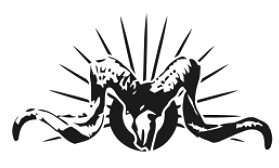Great Game manuscript gifted to RSAA: George Hayward
Dr Rosie Llewellyn-Jones MBE, RSAA Archivist, writes on the gift by Kathleen Hopkirk, widow of the author Peter Hopkirk, to the RSAA of a 19th century notebook written by George Hayward, one of the early players of the Great Game.
He fell among thieves was a favourite Victorian poem by Sir Henry Newbolt, recited in drawing rooms throughout England. It is a highly emotive and somewhat inaccurate account of the murder of George Hayward, an early explorer during the Great Game that was played out between British India and Russia. Newbolt was only a boy when news of Hayward’s death in the Hindu Kush on 18 July 1870, reached England. But there was something both inspiring and fearful about this lonely, thirty-year-old man, disguised in ‘native dress’ who had explored the Pamirs, the roof of the world, with only four Tibetan servants and baggage-carrying animals.
Hayward was a Yorkshireman who joined the British army in India and was stationed for some time in Multan, where his interest in exotic, out of the way places (preferably with fierce tribesmen), developed. Leaving the army, he wandered around for three years before approaching the Royal Geographical Society in London, who promptly funded his first exploration to Yarkand and Kashgar, then unknown to western travellers. The small towns, once prominent on the Silk Road, formed part of eastern Turkestan, or Kashgaria, as it was also known.
‘Journey from Leh to Shadula on the frontier of Eastern Turkestan with exploration of the Source of the Karakash River, Octr and Novr 1868’ is the title of Hayward’s handwritten account which has been donated to the Royal Society of Asian Affairs by a member, Mrs Kathleen Hopkirk, widow of Peter Hopkirk, the travel writer. Hayward wrote it while under house-arrest in Yarkand in January 1869, where he was temporarily detained by Yakub Beg, the powerful Muslim leader who had fought off the Chinese in the region. Hayward subsequently used a small part of this travel journal to prepare a longer, formal report that was published by the Royal Geographical Society, which awarded him a prized Gold Medal.
The journal itself is small, just over 7 by 5 inches, with 31 folios. The pages, which are covered on both sides with legible handwriting in brown ink, have been professionally trimmed and sewn together in the centre. The whole thing has at some point been folded in half lengthwise, probably to fit into a jacket pocket. The paper is not watermarked. The text, which I have transcribed, has an immediacy about it, which is missing from the printed report. It was written while still fresh in his mind. Hayward is clumsy – he drops both his sextant and his log-book and has to trek back again to find them. His pony, a ‘Kulmâk grey, a capital goer over rocks & stones’, dies three weeks into the expedition. Because of the intense cold, his ink bottles shatter and his water-colours and brushes freeze so he can’t paint anything. (He was a competent artist.) He comes across the frozen body of an unfortunate Yarkandi who has died of cold and starvation, but his Tibetan staff refuse to bury the body, and it seems that no-one has brought a shovel or pick on the expedition. Fuel, in the form of short thick grass, called ‘boorsee’ is in short supply, and water even more so.
Hayward struggles on – one man against almost impossible odds, one feels. But he writes: ‘notwithstanding the great cold I enjoyed my exploration thoroughly for as this country was totally un-explored I doubt if any human being had ever been down this valley –probably not – and it was interesting in the extreme for at the time I did not know what river I was following’. The excitement of the unknown was to bring him back on two further expeditions, though none as challenging as this first journey. The prime suspect in his death, eighteen months later in the Yasin valley, was Mir Wali, a local chief, greedy for the expensive gifts that Hayward was carrying with him to present to other headmen.
But was Hayward himself partly to blame for his own death? He had written earlier of an ‘insane desire to try the effect of cold steel across my throat’ and there is something more than reckless about him that is hinted at in his notebook. His body was later found, roughly interred, by an Indian search party and brought back to Gilgit where it was properly buried in what became the Christian cemetery. Sometime during the last century a new tombstone was erected over his grave ‘at the instance of the Royal Geographical Society of London’ to commemorate ‘a gallant Officer and accomplished Traveller’. ‘Hayward’s Rock’ as it was known, near the site of his death, was visited in 1996 by Hugh Leach (one of our Honorary Vice-Presidents), who donated his photographs and his own account to the RSAA recently. Hayward continues to fascinate us, nearly 150 years after his death.


No comments:
Post a Comment